Video Author: Chris Dixon, Founder and General Partner of a16z crypto Translator: Qianwen, ChainCatcher
In this video, Chris Dixon, Founder and General Partner of a16z crypto, shares the history of the internet, protocol networks, enterprise networks, the similarities and differences with blockchain, and the potential unleashed by truly open-source and decentralized networks.
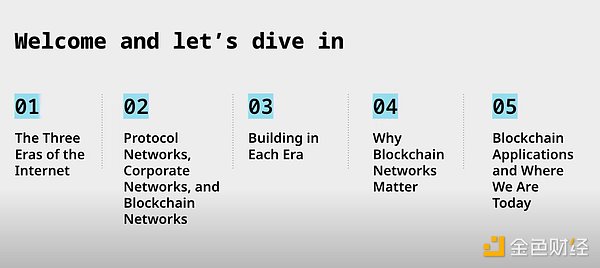
The Three Stages of the Internet
There are many theories about the development of the internet. In my opinion, it can be divided into three core stages, and we are entering the third stage. Each stage has a key network architecture. In my view, networks are the killer applications of the internet, and these networks have various downstream impacts on the economy, user experience, and other aspects. Each stage has its dominant network class and typical computing primitive. In this context, one idea is to have everyone in the world put their information into a large repository for sharing, so that various pieces of information do not get mixed up. To achieve this, some simplified principles need to be followed, resulting in the three stages of the internet.
- Polygon version of OP Stack is here? Polygon official interpretation of what is Polygon CDK.
- Aave V3 vs Compound V3 Quick Comparison
- L2 Stacks War Is it about to end before it even starts?
In the first stage, read. The internet is like a large multiplayer social game, and websites are a fundamental invention. The underlying idea behind this design is that you can put any information, such as code data, into something called a website, which can link to other websites. This is an important encapsulation mechanism and a simplification mechanism, allowing all humanity to have information that can be linked and jumped to, making these contents a digestible unit. We achieved the democratization of information access in the “Year of the Internet,” and the killer applications of that era were Google and Wikipedia. Through the internet, you can find the content you want, which is a magical new experience. Some say that ordinary users now have more information than the US President had 30 years ago. However, it was still a relatively rudimentary (copying) version at the time. The internet gives you the feeling that you’re putting a magazine on a website, where you can submit forms and do some one-way interaction, but it’s not a truly interactive experience.
In the second stage, write. The key is how to enable true two-way interaction between the internet and users, democratizing publishing. This gave rise to blogs, where people could publish information in a simple way. Many ideas from figures like Mark Zuckerberg came from the early blog community. Blogs contained various content, such as photos and links, which extended into a whole set of interesting products.
In the third stage, protocols. This was a great design decision early on. How should people build a global multiplayer social game? Without tools like Google or AWS data centers, you had to build it in a peer-to-peer manner. Thus, protocols were born. These are a series of standards, such as HTTP for the web and SMTP for email. Protocols are like languages, like English, telling you the standards to follow for certain operations. If someone builds, opens, sends emails, or uses any other tool, that protocol is built into the software. When you download that software, you join email, you join the internet.
It is important that there is no central intermediary, and no one controls everything. This is a community-driven situation where people can freely discuss things. Most importantly, it doesn’t cost you a penny. Of course, you need to buy a domain name, but after that, you can build websites that belong to you. Anyone with good ideas, under legal circumstances, can establish a website and own the value brought by the website.
One important invention in this regard is DNS. DNS is the naming system of the domain name system. For example, I own Cdixon.org, which maps to an IP address. The important thing is that I control this mapping – that is, users control the mapping, transferring all ownership of the network to the users. This means that I can build my website, I can change the hosting provider for my website if I don’t like their high fees or low speed. I have the right to change, but I still retain my network, search results, and email (some may say that later Gmail monopolized email, but at least that happened later). In short, if you don’t like it, you can leave, which forces the provider to follow our thinking. However, when we enter the era of enterprise networks, although you can leave, you are actually not really leaving. For example, on Facebook, you are allowed to download CSV files and take them away, but you cannot take away your fans and audience. The current situation is that the network is monopolized. For example, if you ask a blogger on the street, most people are not interested in building their own websites, which is the original intention of the network.
Network Stagnation
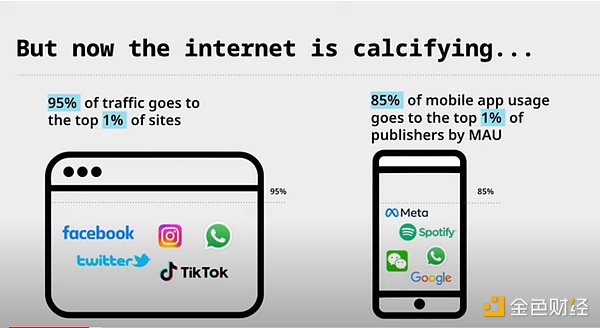
The network has stagnated. Ninety-five percent of the traffic goes to the top one percent of websites, and according to MAU, eighty-five percent of mobile device usage flows to the top one percent of publishers. Economics is similar. The Nasdaq 100 index is mainly occupied by the index of the top five technology companies. We are increasingly heading towards a monopolistic world, which is very different from the original vision.
For me, the Internet is a tool for building networks, such as the TikTok network, Instagram network, Uber network, and so on. As I described earlier, concepts like DNS and the way networks are built will ultimately have a very important downstream impact on the economy, governance, and who can build networks. For example, many of my friends were developing Twitter applications and Facebook applications around 2010, but all these companies were wiped out on the platform because these big companies changed APIs, changed rules, and unilaterally controlled everything. So network architecture determines everything.
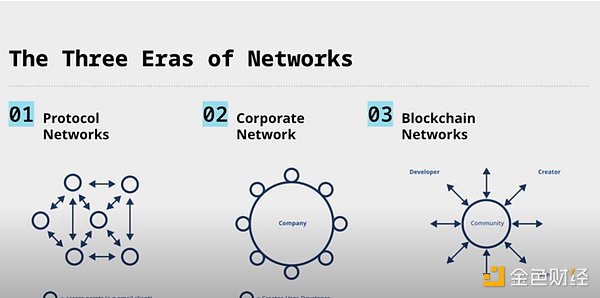
Here I will talk about the take rate. For example, on YouTube, they will take a cut of the fees. But if different protocol architectures (such as RSS) replace social networks, a large portion of these fees will flow to creators, users, and software developers instead of intermediaries. Maybe this is a good thing, but perhaps it is a bad thing. But what I want to express is that architecture determines everything. For example, if you build an enterprise network, you will eventually face economic and social problems, which are today’s economic and management models.
Blockchain is a new type of virtual computer built on computer networks. The main feature of blockchain is that it disrupts traditional computing architectures. If Google’s servers were placed on the network, they would eventually control the network because they control the hardware and can modify the software, which they have been doing. Imagine if Google announced the launch of Google Coin and promised to issue only a certain amount of it. No one would believe it because they would eventually backtrack on their promise, there would be changes in the management team, such as the departure of the founder. In short, things would change.
What blockchain does is say: we give power to software. For example, by writing a smart contract on Ethereum, you can control everything. The most important thing is: you can build a network on the basis of blockchain, which can obtain the social benefits of protocol networks as well as the competitive advantages of enterprise networks.

The benefit of a protocol network is that there are no middlemen, and all funds flow to the edge of control. This allows for various interesting innovations. However, they have a major weakness, which is difficulty in financing, mainly through government funding and other means.
In fact, the RSS protocol used to be popular before, but it lost to YouTube later, partly due to different strategies. YouTube had no traffic at first, so they adopted a strategy of free hosting to attract traffic. For example, I had traffic on my own website, but YouTube offered me free hosting, so I uploaded my videos and let them host them, and then they embedded a widget into my website. That’s how YouTube started. But RSS had a different strategy. You could buy a domain name, but you had to pay for hosting. Hosting videos was very expensive, so YouTube subsidized it. This is a structural advantage of enterprise networks and also the reason why RSS lost to software like Facebook and Twitter. Initially, companies like YouTube and Twitter supported RSS functionality and the use of APIs, but later they stopped providing these services.
So I think this is a cycle. For example, at the beginning, there is very little traffic, and companies try everything to get creators to join and offer various subsidies. But eventually, the scale of the company will generate huge network effects, and the incentive mechanism will change, with profitability becoming more important. So this is just a core logic. For these enterprise networks, the larger the scale, the less motivation there is to interoperate with other networks, support other networks, and allow creators to enter. I call this the “extract circle”. At the beginning, you try to attract all kinds of people to join your network, but at some point, you start extracting from them. Of course, there are also many efforts to try to mitigate this situation, such as Google’s promise not to do so. But the reality is that once the founder leaves, the company’s strategy will shift to profit first, because if you don’t do it, other competitors will. So we are in a world that is almost monopolized, and innovation is suppressed.
Blockchain Should be an Organically Growing City
Blockchain still has a core, which is the blockchain network. Taking Uniswap as an example, the smart contract code is the core of its operation, and the core concept includes immutable code. Uniswap is a good example. Even the community cannot change the code. If they release a new version, it is a new set of immutable code. This is the principle of “do no evil”. They cannot change the rules because they are specified in the code. So as a developer and a user, you can decide for yourself because there is competition and choice here.
The core of the blockchain is much smaller than that of an enterprise network. It is more like building a city rather than a theme park. Enterprise networks are like theme parks because every feature of Facebook and Twitter is built by themselves. No matter what kind of network you choose, it is created by the company’s employees. Essentially, they have stifled all innovation.
In the late 1990s, there was a proliferation of spam messages. So how was this problem eventually solved? Although the problem is not completely solved now, at least the situation has improved. The market intervened. At that time, there were about 50 venture capital-backed companies solving spam emails, and Gmail eventually acquired the startup Postini. Similarly, you can use the power of the market to create a blockchain. If you want to establish a blockchain network here, you would want to establish the core of the network. Just like building a city, you need a mayor, a city hall, a fire department, and a police department, which all involve basic rules and management.
You can build such a network to create incentives for people. The design of these mechanisms leaves ample room for design, and you can also accumulate funds to provide funding for developers and achieve all the things that RSS cannot do. This is what I call a “win-win” situation. You will get this open ecosystem, these cities, these digital cities. On this basis, you can build future applications and networks, as well as all the wonderful things around the protocol network, but you can also obtain funds and functionality. And from a technical perspective, some new naming systems like ENS can also solve the domain name problem I mentioned earlier, making the user experience more modern.
Ideally, in today’s era, if you cannot achieve the same level of functionality as an enterprise network, you are likely to fail. User demands are high, and they expect a good user experience. So fundamentally, this architecture is centralized in terms of logic, but decentralized in terms of organization. For example, ENS has a central database, but it is not controlled by individuals but by the community.
Federated Network
A federated network is still a protocol network, and its logic recognizes the problems brought by individual control. The solution is to divide this huge dictatorship into many small dictatorships. Each server is a mini dictatorship, and as long as the federated subnetwork is small enough, people can have autonomy and they can check and balance each other. This is the way to maintain decentralization of power.
In the 2000s, services like Twitter and Tumblr promoted themselves as RSS servers, but the reality was that one or several servers either didn’t work or were clustered around a single server, especially in a federation where there was no typical central location to store the namespace and everything else. So these servers crossed each other and couldn’t operate “gracefully”, eventually requiring a sharding system. If the entire system can eventually operate, then certain servers will also become powerful, and we will experience a history of monopolies again. I think you need a typical central core to have a system that matches the future and modern enterprise networks.
What I want to express is that cities are better than theme parks. The interaction between private ownership and public ownership in cities is very important. For example, if I open a small restaurant, I rely on foot traffic on the street and public facilities, which is a form of interaction. If only central institutions make decisions, it is difficult for them to be aware of people’s specific needs. Therefore, in a well-designed city, there will be diversity between public facilities, parks, and infrastructure, giving people a sense of an open, shared city, while also promoting entrepreneurship. But at the same time, you can also leverage the creativity of the free market, the internet is a typical example, it embodies various interesting things, such as Google, Wikipedia, etc. There are various things here, in a great city, various organic and wonderful things interact with each other, which is far superior to a carefully planned and managed place.
Why is Blockchain important?
So let’s discuss why people would want to see a world where a blockchain network is popularized. Because this new network architecture combines the essence of previous architectures. First is community ownership, similar to a protocol network. Here, you have community ownership, where the concept of ownership includes read and write ownership, and you can truly own a part of the network.
Tokens are one of the key concepts of this era, encapsulating ownership. I think tokens can be anything, they can be things in the physical world, the digital world, they can be code, games, art, they can be anything. Tokens leave many impressions on the public that are similar to the characteristics of currency, which is a very narrow view. For me, tokens are like websites, you can put anything in them. In a well-designed blockchain network, you can put voting power, the ability to own a portion of the network, and other things in them to share economic benefits.
Lower fees. Money will ultimately flow somewhere, do you want it to flow to network operators or network participants? This is not only the principle of altruism but also a competitive advantage. You can go find creators, musicians, all these people, and offer them lower fees, which is one of the powerful factors that will drive the success of this movement. In fact, this is a better economic proposition for all participants.
Incentivize innovation. What you build is yours. The rules are written into the code and cannot be changed by others, while also enjoying the advantages of crowdfunding in the corporate network. Let me give you an example. A few years ago, there was a vulnerability called “Heartbleed” in SSL (SSL can be understood as a standard technology for protecting internet connections). It was a very dangerous vulnerability that could threaten all encryption technologies on the internet. Half of the developers were researching SSL, but there was almost no funding, so the problem was not solved at that time.
Some may say, look at Linux, it has sufficient funding; but if you take a closer look, the biggest contributor to Linux is Intel, and Intel has strategic reasons to support Linux because their main competitor is Windows, so they have to analyze all political alliances. However, the internet doesn’t naturally have its own allies, so the internet needs its own native form of funding in order to have a chance of success, and that’s exactly what blockchain can provide.
Tokens
Tokens are a product of the tradition of electronic games, which pioneered virtual economies. For example, “League of Legends” and “Fortnite” are mainstream video games. In the past, people used to buy physical games, but now almost all modern game companies don’t charge based on the game itself, but make money through virtual economies.
In the design of blockchain networks, if you want to design a virtual economy, you can understand tokens as flowing water, with places where tokens flow out (faucets) and places where tokens flow in (taps). For example, staking and airdrops are forms of taps. Access fees and transaction fees are faucets. You want to achieve a balance between the two, and balance is also needed between supply and demand. But you also want to incentivize good behavior through taps, and you want blockchain to compensate for the shortcomings of mechanisms like RSS.
Incentive mechanisms are very important here, as you can use them to provide funding for developers. For example, the example I mentioned earlier of YouTube hosting can be understood as a tap. Ideally, the faucet should be consistent with the utility of the underlying application. For example, Ethereum’s faucet works well. Ethereum is a globally shared supercomputer in the cloud, owned by no one and accessible to anyone. It’s like an old-fashioned mainframe computer with limited resources, charging you for using the computer with Ether. The convenience of this is that as people build more applications for Ether, the demand for Ether should increase, and Ethereum will become a more popular network.
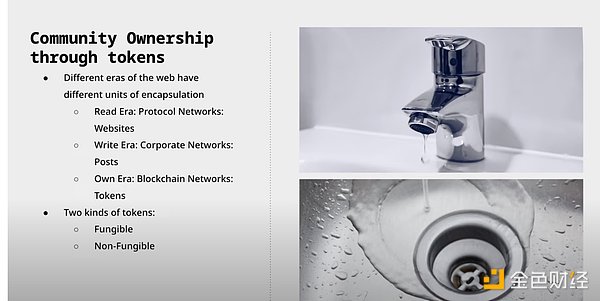
So, it is closely related to the practicality of the economy. If someone creates a popular game based on Ethereum, it will increase the demand for Ethereum, which is economics. This is the same as what economists have been discussing for hundreds of years, the economics of the internet. This is also the relationship between economics and supply and demand. If you build a popular network and link the network’s token to the utility of the network, it will generate basic sustainable demand, rather than speculative demand.
There is speculation in the current token prices, just like there is speculation in every technology market. However, speculation is not sustainable because the focus is on creating fundamental value, creating new networks, giving these networks the advantages of protocol networks, and better utilizing the advantages of enterprise networks to create new virtual economies. Tokens and incentive mechanisms are used to achieve adoption, promote behavior adjustment, and achieve all the wonderful results I mentioned, such as return on investment.
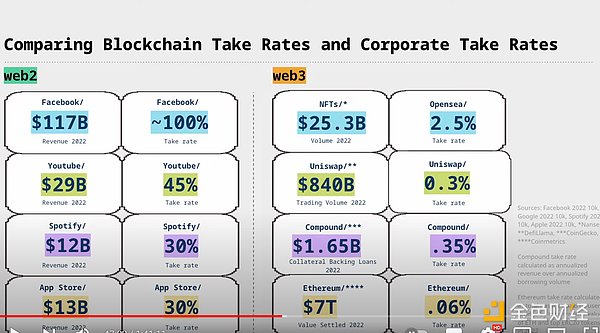
The above figure shows the extraction rate. I guess that with the emergence of market competition, there will be downward pressure, which means that over time, many of these extraction rates will decrease. For example, OpenSea does not own NFTs, and they cannot force you to stay there. Networks must have the right to competition, which lowers prices, adoption rates, or network prices. So I think it is possible for this interest rate to decrease in the future.
Composability
Composability is the truly interesting part of software. The network designers create the core, and then the ecosystem builds everything around the core. It’s a very exciting thing. If you trace the history of technology, you will find that the history of composability goes back a long time, specifically, it is more focused on networks and open-source software. I remember in the 1990s, Linux was very niche, and open-source was a particularly radical idea. It originated from Richard Stallman in the 1980s, who believed that no one should own software and he was against intellectual property.
In the 1990s, there was a famous article called “The Cathedral and the Bazaar”, which presented two concepts. One is the cathedral, like Microsoft, which was the Google of that era, dominating, and the bazaar was the bustling crowd developing open-source software. Now, the majority of operating systems in the world are Linux. Your Android phone is Linux. All data centers and IoT devices are Linux, so this system has completely won. It turns out that packaging a group of people on the internet is a better way than making software in the “cathedral”. The bazaar can be said to be a better way, and networks, Wikipedia are examples.
Because of the composability of networks, a global knowledge base is being established, and everyone has more power. Personally, the most frustrating part of the enterprise network architecture is that all innovation is limited to “clerical staff” (such as product managers, etc.), and innovation is largely stifled.
Our current stage of development
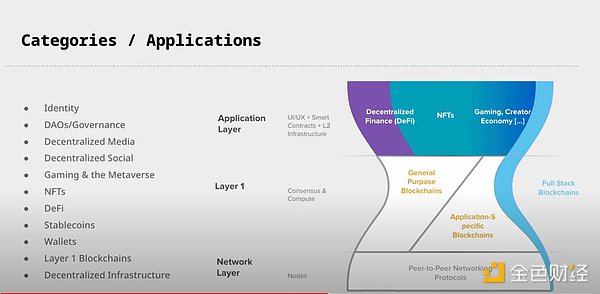
As shown in the above figure, our team has made a rough classification of applications and infrastructure. Our theory is that when a situation occurs, such as a price increase, the people around will also get excited. For example, they would say, “I’m going to read the Ethereum white paper, I want to understand it,” and then they really become fascinated with it. Some people are speculators, but some people are genuinely interested in it, so they start companies and contribute to open-source, and so on. Usually, it takes some time for the seeds to fully bloom, and then you will see a new exciting cycle. So we did this data analysis project shown in the figure below.
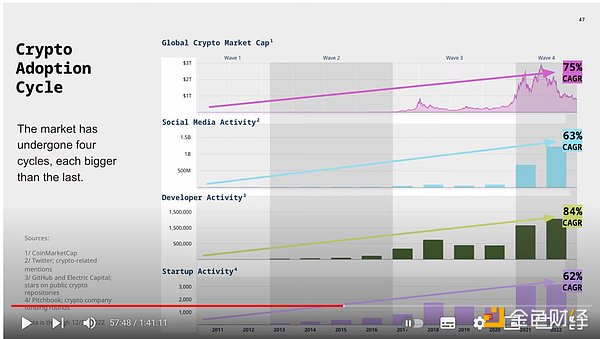
As shown in the figure, its development is not as stable as that of internet software, and there is some chaos. This reminds me of artificial intelligence. Artificial intelligence has also gone through a period of chaotic development. Since Turing published his paper 70 years ago, artificial intelligence has experienced “summers”, “winters”, and so on. Therefore, larger technologies are more likely to experience such chaotic cycles multiple times, because it involves factors such as market sentiment and funds. If you know about the S-curve technology, then we are currently at the bottom.
The Golden Age
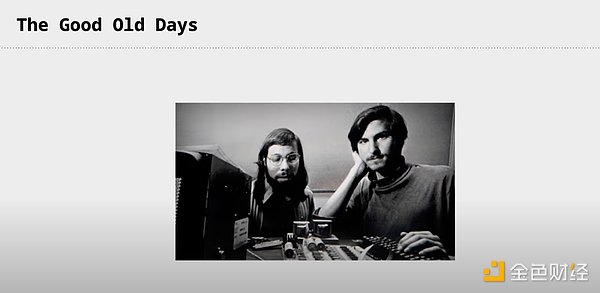
I am a loyal fan of history. I have read every book about computing history, technology, and history. I try to read these contents because I am a loyal fan of stories. I used to be an entrepreneur. I like the stories that happen in a room. Just think about it, three people sitting together, drinking beer, discussing an idea, it’s really incredible. I used to be an early investor in many companies. In this world, being able to create software and be part of these early movements is really amazing.
When you read history, you will think that doing things like personal computers in the 1980s must be obvious, just like “history doesn’t repeat itself, but it rhymes”. There will always be something different, like encryption technology, which of course faces a lot of criticism. Bill Gates’ vision at the time was also revolutionary, to have every household have a computer, and everyone would have a part of the network, which is a great vision. In fact, the entire computing history of the 1930s in the 20th century is very interesting, such as the stories of logicians. For example, the story of Fairchild Semiconductor Company, Robert Noyce, and others. I encourage you to read about them.
The story of building personal computers at that time is actually somewhat similar to our hackathons today. Some people said, let’s make a PC, it would be cool, the price of an Apple phone is $5,000, but there are few things you can do with it, so it’s better to build a personal computer. At that time, no one realized that it would change the world.
I am excited at this moment. Why? Actually, you should be excited too, because these are very special moments when you can witness the new computing movement, AI, VR, and a series of technological changes.
This time the revolution really affects the future of the internet, and we must make a decision about what kind of internet we want. Do we want an internet monopolized by a few companies? Or do we want an open, decentralized, and innovative internet? Currently, I seem to have not seen any good regulation that can achieve an open internet. Perhaps the form of a protocol network will make a comeback after 30 years. For me, I think this is the most trustworthy way so far to bring the internet back to its roots.
Of course, this is also why you are here. I believe this is a great entrepreneurial opportunity where you can truly make a difference.
Like what you're reading? Subscribe to our top stories.
We will continue to update Gambling Chain; if you have any questions or suggestions, please contact us!